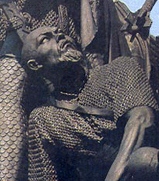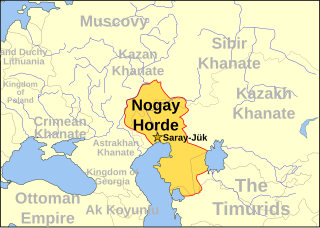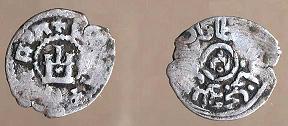
The Golden Horde, self-designated as Ulug Ulus, was originally a Mongol and later Turkicized khanate established in the 13th century and originating as the northwestern sector of the Mongol Empire. With the division of the Mongol Empire after 1259, it became a functionally separate khanate. It is also known as the Kipchak Khanate or the Ulus of Jochi, and replaced the earlier, less organized Cuman–Kipchak confederation.

Mamai was a powerful Mongol military commander of the Golden Horde. Contrary to popular misconception, he was not a khan (king), but was a kingmaker for several khans, and dominated parts or all of the Golden Horde for almost two decades in the 1360s and 1370s. Although he was unable to stabilize central authority during the 14th-century Golden Horde war of succession known as the Great Troubles, Mamai remained a remarkable and persistent leader for decades, while others came and went in rapid succession. His defeat in the Battle of Kulikovo marked the beginning of the decline of the Horde, as well as his own rapid downfall.

Tokhtamysh was Khan (ruler) of the Golden Horde, who briefly succeeded in consolidating the Blue and White Hordes into a single polity.
This is a timeline of major events in the Muslim world from 1400 AD to 1499 AD.
Nogai, or Noğay was a general and kingmaker of the Golden Horde. His great grandfather was Jochi, son of Genghis Khan.

The Nogai Horde was a confederation founded by the Nogais that occupied the Pontic–Caspian steppe from about 1500 until they were pushed west by the Kalmyks and south by the Russians in the 17th century. The Mongol tribe called the Manghuds constituted a core of the Nogai Horde.
Edigu was a Kazakh amir of the White Horde who founded a new political entity, which came to be known as the Nogai Horde.

The Great Horde was a rump state of the Golden Horde that existed from the mid-15th century to 1502. It was centered at the core of the former Golden Horde at Sarai on the lower Volga.

Mengu-Timur or Möngke Temür was a son of Toqoqan Khan and Köchu Khatun of Oirat, the daughter of Toralchi Küregen and granddaughter of Qutuqa Beki. Mengu-Timur was a khan of the Golden Horde, a division of the Mongol Empire in 1266–1280.

Tokhta was Khan of the Golden Horde from 1291 to 1312. He was a son of Mengu-Timur and a great-grandson of Batu Khan.

The Tokhtamysh–Timur war was fought from 1386 to 1395 between Tokhtamysh, the khan of the Golden Horde, and the warlord and conqueror Timur, founder of the Timurid Empire, in the areas of the Caucasus Mountains, Turkestan and Eastern Europe. The battle between Timur and Tokhtamysh played a key role in the decline of Mongol power over the Russian principalities.
Urus Khan was the eighth Khan of the White Horde and a disputed Khan of the Blue Horde; he was a direct descendant of Genghis Khan. Urus himself was the direct ancestor of the khans of the Kazakh Khanate.

Dawlat Berdi, also known as Devlet Berdi, was Khan of the Golden Horde who reigned from 1419 to 1421, and again from 1428 to his death in 1432. He was the son of Jabbar Berdi and a descendant of Berke Khan.
Sayid Ahmad I was Khan of the Golden Horde from 1427 or 1433 until 1455. Unlike the last five of six khans, Ahmad was a younger son of Tokhtamysh.

Jalal al-Din or Jalāl ad-Dīn was Khan of the Golden Horde in 1411–1412. He was the son of Tokhtamysh, Khan of the Golden Horde until 1395, by Ṭaghāy Beg Khatun, the daughter of Ḥājjī Beg. He is also famous for his written history of the Mongol Empire. He is also known as the Green Sultan, a false etymology based on the apparent meaning of a Slavic rendition of his name, Zeleni Saltan.

Ulugh Muhammad or Muhammad Khan was a medieval Tatar statesman, Gengisid, Khan of the Golden Horde, ruler of Crimea (1437), and the founder of the Khanate of Kazan, which he ruled from 1438–1445. He was the son of the oglan Ichkile Hassan and the cousin of Tokhtamysh. He received the nickname "Ulugh", meaning older or large, in contrast to Küchük Muhammad, meaning younger or small.
The Kazakh War of Independence (1468–1500) was a conflict fought in Central Asia between the Kazakh Khanate and the Uzbek Khanate, which attempted to maintain its control over most of modern-day Kazakhstan, which at the time was under Uzbek rule. The war started after Abu'l-Khayr, Khan of the Uzbek Khanate, attacked Zhetysu in 1468 which was controlled by a small band of rebel Kazakhs who had split from the original Uzbek Khanate. Abu’l Khayr did so in an attempt to prevent the growing Kazakh influence among the steppe. However, he died unknowingly, making it easier for the Kazakhs to expand their influence. After Abu'l-Khayr Khan's death, the Uzbeks continued to be ruled by the Shaybanids who fought against the Kazakhs in the cities that were on the Syr Darya until both sides agreed to peace in 1500 with the Kazakh Khanate gaining its sovereignty from the Uzbek control. At the end of the war, the Uzbek Khanate transferred most of Kazakhstan to the Kazakh Khanate.

Karīm Berdi was Khan of the Golden Horde on several occasions, in 1409, 1412–1413, and in 1414.

The Great Troubles, also known as the Golden Horde Dynastic War, was a war of succession in the Golden Horde from 1359 to 1381.











